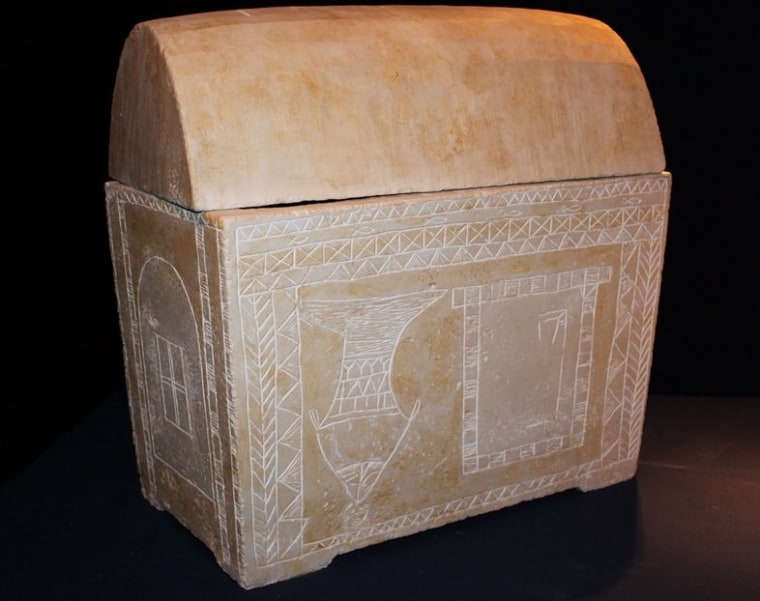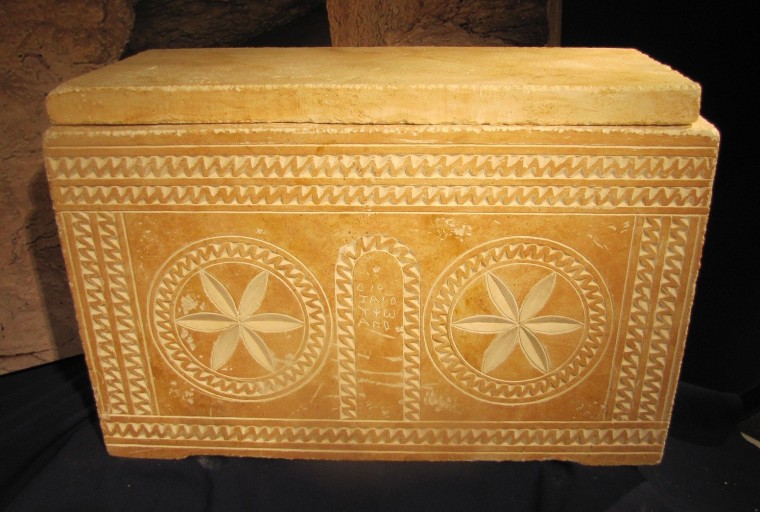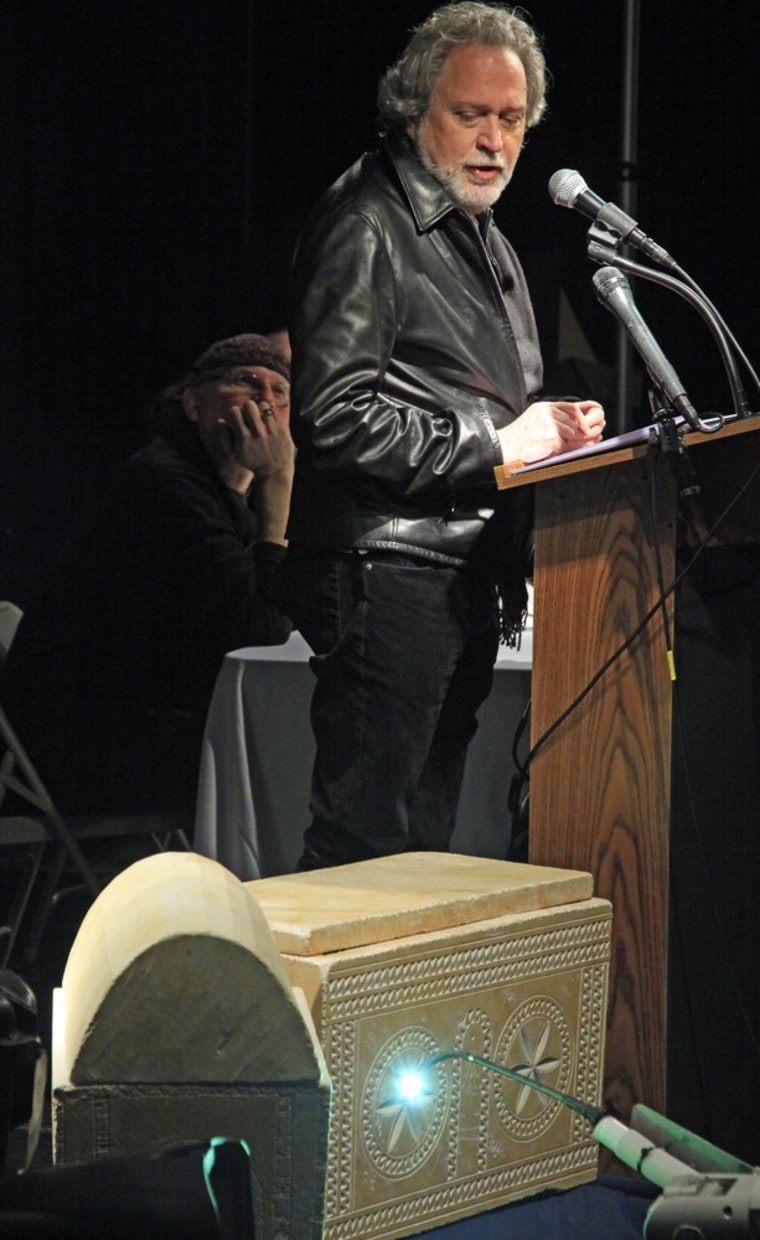
The debate over a 1st-century "Jesus Discovery" tomb that may, or may not, contain the earliest known evidence of Christian iconography has taken on some of the fervor of a holy war, with some scriptural scholars protesting what they see as the "Da Vinci Codification" of modern culture.
The controversy focused on whether a fishlike figure carved into one of the limestone bone boxes from the Jerusalem tomb was really meant to be a fish — or something else. It's a key point, because fish have historically been seen as early Christian symbols, and such symbols have not previously been found on Jerusalem bone boxes.
"The 'Jonah Fish' is just the next installment in the Jesus-archaeology franchise — timed, as always, to precede a major Christian feast," Steven Fine, director of Yeshiva University's Center for Israel Studies, complained in a posting to the ASOR Blog, which is published by the American Schools of Oriental Research. "I, for one, am wearied by the almost yearly 'teaching moment' presented by these types of 'discoveries.' I am hopeful, however, that — this time — a forceful and quick display of unanimous dissent by the leading members of the academic community will be taken seriously by the media and the public at large."
The underground chamber, known as the Patio Tomb because it lies beneath the patio of a present-day condo building, was explored a couple of years ago with the aid of a camera-equipped robotic arm. The project came into the global spotlight this week with the publication of "The Jesus Discovery," a book about the finds made there.
A documentary TV show, reportedly titled "The Resurrection Tomb," is due to air on the Discovery Channel this spring. It's not yet clear whether that show will be broadcast around the time of Easter Sunday, which falls on April 8 this year (April 15 for Orthodox Christians).

This week's claims about the Christian character of the bone boxes seen in the Patio Tomb have attracted sharp criticism from outside experts. The tone of the debate has become so sharp that one of the scriptural scholars behind the discovery, James Tabor of the University of North Carolina at Charlotte, appealed today for an end to the "personal innuendos and ugly charges about greed and corruption."
"I ask my fellow bloggers in our field to circulate this call for a change in our tone and approach to one another," he wrote on his own blog. "Enough is enough. ..."
One of Tabor's partners in the tomb study is Rami Arav, an Israeli-born archaeologist at the University of Nebraska at Omaha who has directed excavations in Israel for more than two decades. Arav told me today that the controversy over the findings was not unexpected.
"Whenever you make a pioneering discovery ... there will always be questions about the interpretation of what you see, particularly when things are not unequivocal," he said. "My philosophy in this kind of thing is that a good theory ... is elegant and solves more problems than it creates."

Believing a fish story
For some, the claims about the "Jonah Fish" constitute a big problem. Tabor, Arav and another partner, documentary filmmaker Simcha Jacobovici, have suggested that the figure alludes to the biblical story of the prophet Jonah, who was swallowed by a sea creature and vomited up alive three days later. That story held extra significance for Christians, who believed Jesus died on the cross and rose from his tomb on the third day.
The critics of the "Jesus Discovery" team say they're not swallowing the fish story. Instead, they maintain that the figure depicts a type of funerary pillar or tower, known as a "nephesh tower," or perhaps an amphora or vase. Some experts included pictures from other bone boxes, showing nephesh towers with pointed roofs.
Arav and Tabor said they had considered the interpretation of the picture as a tower or a vase, but decided that the fish made more sense. "If we suggest it could have been a tower, then we would have to put the ossuary upside down," Arav said. "This doesn't have any precedent, and I think this is even more problematic than saying it is a fish."
The team's video examination of the box also spotted several small, simple fish figures carved into an ornamental border around the main figure.
"It creates problems which I indeed don't think are problems," Arav said. "We know that the Jonah motif appears later on, but that doesn't mean that it began later on. This is not a real problem."
Jacobovici told me that he put the picture to the "Mishi test," named after his 5-year-old daughter. When he heard that some experts were suggesting that the picture showed a tower, he called Mishi over to take a look. "I said, 'What do you see here, sweetie?' She looks very intense, and says, 'A person inside a fish?'" Jacobovici recalled. "It passed the Mishi test."
Why fuss over a fish?
What difference does it make whether the picture shows a fish or a tower? The eventual outcome of the debate could have a big impact on the course of biblical archaeology. If the iconography is determined to be Christian, that would lend much more significance to what otherwise might be seen as a run-of-the-mill Jewish tomb.
What's more, Tabor and Jacobovici contend that the discovery of a Christian tomb strengthens their far more controversial claim, first made in 2007, that bone boxes in a nearby tomb might contain the earthly remains of Jesus and members of his family. The investigators reached that conclusion based on the names inscribed on the boxes, and their similarity to the names listed in biblical accounts of Jesus' brothers and sisters. Tabor says additional studies published since 2007 have strengthened his case, but other scholars are unconvinced.
Arav isn't getting involved in the debate over the "Jesus Family Tomb." But he does want to return to the Patio Tomb and go beyond the fishy debate. "We did non-invasive research in this place, and we discovered what we discovered," Arav said. "But we need also to do some invasive research."
Current estimates suggest that the Patio Tomb was used sometime between 20 B.C. and A.D. 70, when Jerusalem was destroyed by the Romans. Arav would like to get a better sense of the date, and perhaps run DNA tests on the remains "to see if they are associated with groups of people that we know of." It might also be possible to run tests on a cooking pot that was brought out from the tomb years ago, "to see what was offered to the dead," he said.
"There are a lot of things that hard science can help us with," Arav observed. "There are a lot of things to do."
More about bone boxes and biblical archaeology:
- New find revives 'Jesus Tomb' debate
- Doubts voiced about the 'Jesus Discovery'
- 2007: Claims about Jesus' tomb stir up a tempest
- Ancient bone box might point to Caiaphas' home
- Gallery: The archaeology of Christianity
Replicas of bone boxes from the Patio Tomb and the Jesus Family Tomb are on display at Discovery Times Square in New York City, which is also hosting an exhibit about the Dead Sea Scrolls and daily life in biblical times. The exhibit runs through April 15.
Alan Boyle is msnbc.com's science editor. Connect with the Cosmic Log community by "liking" the log's Facebook page, following @b0yle on Twitter or adding Cosmic Log's Google+ page to your circle. You can also check out "The Case for Pluto," my book about the controversial dwarf planet and the search for other worlds.